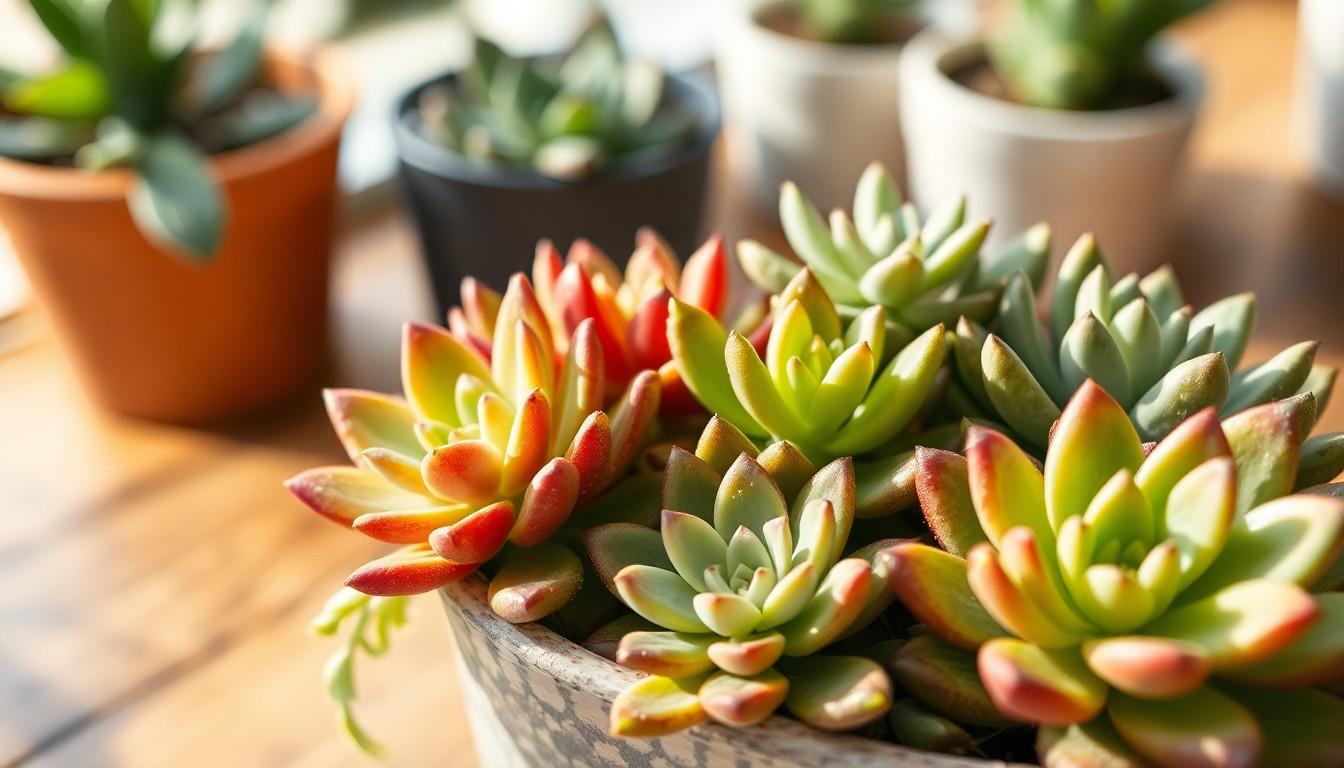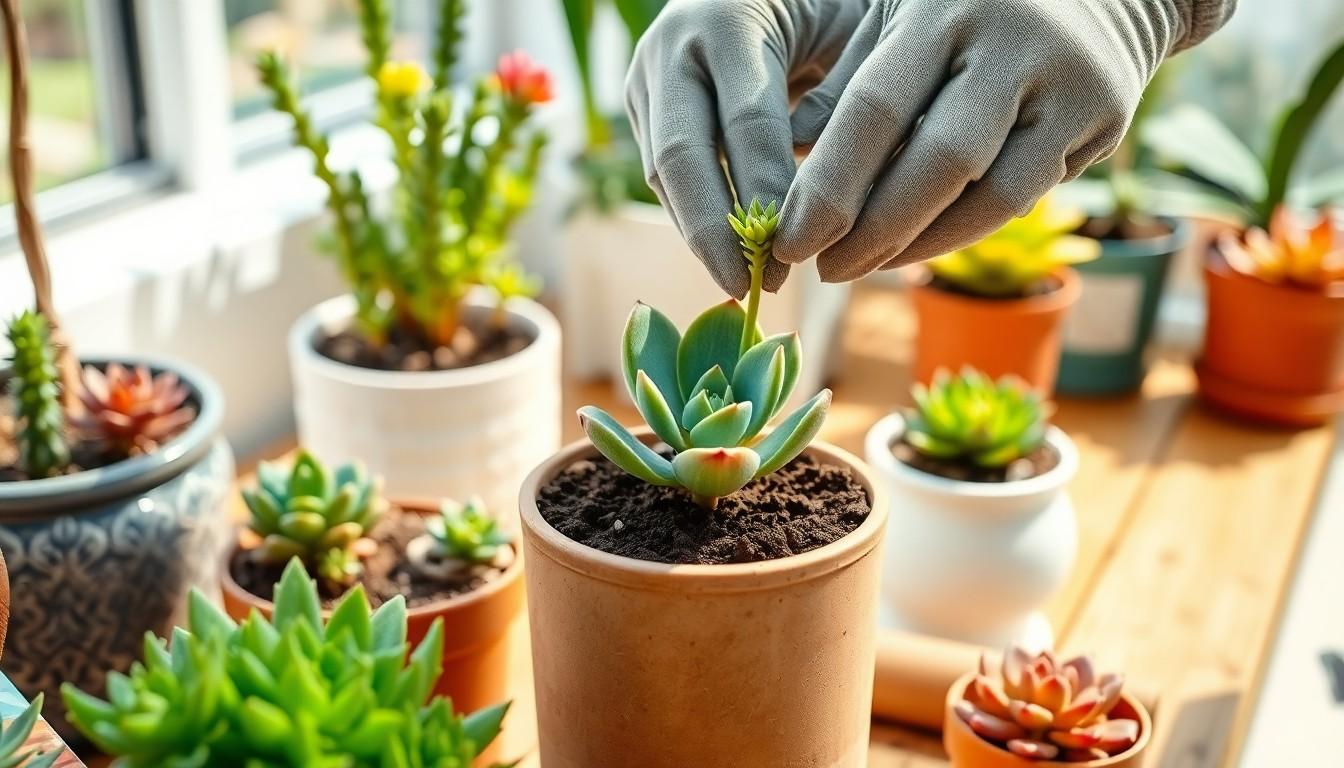Succulents are like the cool kids of the plant world—low maintenance, stylish, and just a little quirky. If you’ve ever admired their plump leaves and vibrant colors, you might’ve wondered how to multiply these delightful green companions. Rooting succulents isn’t just for the horticultural pros; it’s an easy and rewarding way to expand your indoor jungle without breaking a sweat—or your bank account.
Imagine transforming a single succulent into a whole family of them, all while sipping your coffee in your PJs. It’s not magic; it’s just good old-fashioned plant parenting. Whether you’re a seasoned green thumb or a newbie with a penchant for houseplants, rooting succulents can be a fun and satisfying project. Let’s dig into the simple steps that’ll have you on your way to creating a thriving succulent collection in no time.
Overview Of Rooting Succulents
Rooting succulents involves creating new plants from existing ones. It requires simple techniques that promote healthy growth. Many gardeners choose this method to expand their collections.
Materials for rooting include well-draining soil, clean pots, and water. Ensuring the soil is sandy or cactus mix prevents rot. Choosing a healthy leaf or stem cutting is crucial for success.
Temperature and light play significant roles during the rooting process. Succulents thrive in bright, indirect sunlight. Avoiding direct sun prevents scorched leaves and aids in acclimatization.
Moisture management is another vital factor. Watering succulents lightly after planting is essential. Allowing the soil to dry out completely between watering promotes root health.
Observing signs of growth is exciting. New roots can appear within weeks. Healthy cuttings will also exhibit new leaves after a few weeks.
Propagation techniques vary. Leaf cuttings involve detaching a leaf and allowing it to callous before planting. Stem cuttings require cutting a healthy stem and letting it dry before placement in soil.
Monitoring growth conditions ensures optimal results. Providing adequate humidity and warmth aids in successful rooting. Regularly checking moisture levels prevents overwatering and ensures strong roots.
Rooting succulents offers a rewarding experience. Gardeners enjoy transforming one plant into several great additions. Engaging in this simple process enhances both gardening skills and plant collections.
Benefits Of Rooting Succulents

Rooting succulents provides several advantages for gardeners. This process not only promotes healthy growth but also allows expansion of plant collections.
Enhancing Plant Health
Rooting promotes new growth and improves overall plant vitality. Healthy cuttings foster strong root systems, leading to more robust succulents. This method encourages plants to adapt to their environment, increasing resilience against pests and diseases. Freshly propagated succulents often display vibrant colors and improved leaf structures. Monitoring moisture and light conditions during rooting further enhances plant health, ensuring cuttings thrive and develop properly.
Expanding Your Collection
Rooting succulents enables gardeners to effortlessly expand their collections. A single plant can yield multiple new ones through simple techniques such as leaf or stem cuttings. This expansion not only enriches a garden but also provides opportunities to share with friends and family. Fostering a variety of plant types creates visual interest and versatility in indoor or outdoor spaces. Rooting succulents serves as an economical way to cultivate diverse species without needing to purchase new plants.
Methods For Rooting Succulents
Rooting succulents can be achieved using various techniques tailored to different types of cuttings. Each method presents unique benefits while promoting healthy growth.
Leaf Cuttings
Leaf cuttings serve as a popular technique for propagating succulents. Select a healthy leaf from a mature plant, ensuring it’s free from blemishes. After cutting, allow the leaf to callous over for 1 to 3 days. This step prevents rot during the rooting process. Dust the cut end with a rooting hormone to enhance the odds of successful growth. Place the leaf on well-draining soil and mist lightly, ensuring the soil remains dry between waterings. Within a few weeks, new roots and tiny plantlets should form at the base, signifying successful propagation.
Stem Cuttings
Stem cuttings provide an efficient method for rooting succulents. Choose a healthy stem from an established plant, ideally measuring 3 to 6 inches in length. After cutting, let the stem sit for 1 to 3 days to callous. This prevents moisture absorption issues that can cause rot. Similar to leaf cuttings, applying rooting hormone enhances rooting success. Position the cut end in well-draining soil, ensuring it’s stable. Lightly water the soil while allowing it to dry out between waterings. New growth can appear within weeks, indicating successful rooting.
Offsets
Offsets are another effective way to propagate succulents, particularly for those that naturally produce them. Look for small rosettes or pups at the base of the parent plant. Gently twist or cut these offsets away. Ensure each offset has roots attached if possible. After separation, let them dry for 1 to 3 days to callous. Plant the offsets in well-draining soil and water lightly. They typically require minimal care and will establish themselves easily. Over time, offsets develop into healthy, mature succulents with minimal fuss.
Factors Influencing Root Development
Root development in succulents depends on several key factors that encourage healthy growth. Understanding these factors aids in optimizing propagation success.
Temperature and Humidity
Temperature significantly affects rooting success. Ideal conditions range from 70°F to 80°F, ensuring warmth that encourages root development. Humidity also plays a role; a moderately humid environment promotes moisture retention without causing rot. When humidity levels stay around 40% to 50%, cuttings can thrive. Overly dry conditions may lead to dehydration, while excessive humidity encourages fungal growth. Protecting cuttings from drafts and direct air will further enhance growth conditions. Adjustments can tailor the environment to specific succulent types, making it easier to achieve strong roots.
Soil Type
Soil type directly influences root health. Well-draining soil is essential for succulents, preventing water accumulation that can lead to root rot. A cactus mix, composed of sand and perlite, offers excellent drainage and aeration. When planting cuttings, ensure they’re placed in soil that allows air circulation around roots. Opt for coarse materials that facilitate drainage while retaining some moisture. Regular checks on soil moisture levels can indicate when watering is necessary. Appropriate soil composition accelerates healthy root development, providing a reliable foundation for future growth.
Common Mistakes To Avoid
Avoid using potting soil for succulents, as it often retains too much moisture, leading to root rot. Use a sandy or cactus mix instead, which allows for proper drainage.
Neglecting to allow cuttings to callous can result in rot. It’s important to let cuts dry for a few days before planting to promote healing.
Overwatering remains a common error. Water lightly after planting and ensure the soil dries completely between waterings to thrive.
Direct sunlight can scorch delicate leaves. Keep newly planted cuttings in bright, indirect light to foster healthy growth.
Ignoring temperature and humidity levels can hinder root development. Maintain temperatures between 70°F and 80°F, with humidity around 40% to 50%.
Inadequate light creates weak, leggy plants. Position succulents correctly to ensure they receive adequate light for optimal growth.
Using dirty tools can introduce pathogens. Always use clean scissors or knives when taking cuttings to prevent infections.
Failing to monitor the growth of cuttings can lead to missed signs of distress. Regularly check for new roots or leaves to track progress.
Not understanding the specific needs of different succulent species can result in neglect. Research each plant’s requirements before attempting propagation.
Rushing the rooting process can lead to failure. Patience is crucial as new roots take time to establish, allowing for successful propagation.
Conclusion
Rooting succulents opens up a world of possibilities for any gardening enthusiast. By following simple techniques and understanding the specific needs of these resilient plants, anyone can cultivate a thriving collection. The joy of watching new roots develop and the satisfaction of nurturing new life are rewarding experiences that enhance gardening skills.
With the right materials and conditions, propagating succulents can be a fun and economical way to expand a garden. Whether using leaf cuttings, stem cuttings, or offsets, each method provides an opportunity for creativity and growth. Embracing this process not only enriches personal spaces but also fosters a deeper connection to the art of gardening.

